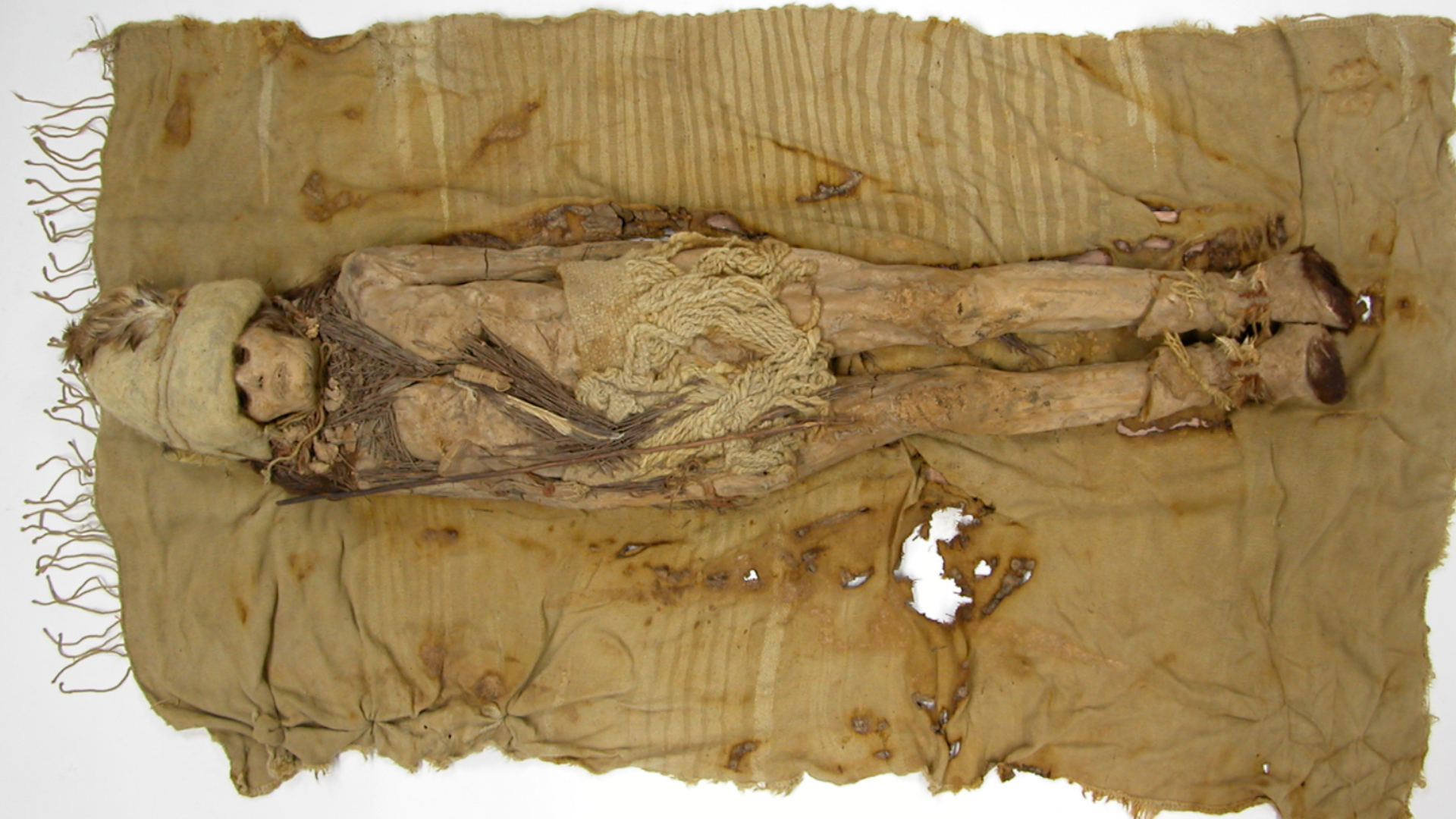
Scientists uncover 3,600-year-old cheese on mummified bodies
By Jack Aylmer (Energy Correspondent), Mathew Grisham (Digital Producer), Mirlie Larose (Producer), Jack Henry (Video Editor)
Moldy cheese in the back of the refrigerator is something almost all have had to deal with, but a new discovery puts a new meaning on old cheese. Scientists have identified nearly 3,600-year-old cheese found on mummified bodies in northwest China.
Media Landscape
See how news outlets across the political spectrum are covering this story. Learn moreBias Distribution
Left
Right
Right
Untracked Bias
It’s believed to be the oldest cheese ever found. An important question researchers wanted to answer was what did the cheese taste like? They say it was likely sour and sharp, similar to some strong-smelling cheeses we know today.
The mummy remains were uncovered at a cemetery in China’s Tarim Basin in the 1990s. What stood out was a white substance spread across the necks of some mummies.
Upon closer inspection and conducting a DNA analysis on the substance, scientists realized the white stuff was indeed an ancient cheese, made from a mix of cow and goat milk, fermented bacteria and yeast. Further tests revealed the presence of a key lactic acid bacteria, and ingredient stilled used today in cheese production in places like Russia and Tibet.

Download the SAN app today to stay up-to-date with Unbiased. Straight Facts™.
Point phone camera here
Researchers believe ancient people used these kefir grains to extend the shelf life of cheese and help combat lactose intolerance, which was more common thousands of years ago. Beyond digestion, these ancient bacterium may have helped trigger immune responses in the human gut.
Along with the cheese, the mummified bodies skin, clothing and hair were able to remain intact due to the dry climate of the region. While it’ still unclear why the cheese was placed in the graves, researchers speculate it may have been a starter culture to continue cheese production in the afterlife.
Jack Aylmer
WE’VE ALL FOUND OLD FOOD HIDDEN IN THE BACK OF OUR FRIDGE, BUT NOTHING COMPARES TO THIS DISCOVERY..
SCIENTISTS HAVE IDENTIFIED NEARLY 3-THOUSAND-600-YEAR-OLD CHEESE FOUND ON MUMMIFIED BODIES IN NORTHWEST CHINA.
IT’S BELIEVED TO BE THE OLDEST KNOWN CHEESE IN THE WORLD.
SO THE ALL IMPORTANT QUESTION – WHAT’S IT TASTE LIKE?
EXPERTS SAY IT WAS LIKELY SOUR, AND SHARP – SIMILAR TO SOME STRONG-SMELLING CHEESES WE KNOW TODAY.
THE MUMMY REMAINS WERE UNCOVERED AT A CEMETERY IN CHINA’S TARIM BASIN DURING THE 1990s.
WHAT STOOD OUT WAS A WHITE SUBSTANCE SPREAD ACROSS THE NECKS OF SOME OF THE MUMMIES.
A RECENT STUDY USED DNA ANALYSIS TO CONFIRM THIS WHITE STUFF WAS INDEED AN ANCIENT CHEESE. MADE FROM A MIX OF COW AND GOAT MILK, FERMENTED BACTERIA AND YEAST.
FURTHER TESTS REVEALED THE PRESENCE OF A KEY LACTIC ACID BACTERIA, AN INGREDIENT STILL USED TODAY IN CHEESE PRODUCTION IN PLACES LIKE RUSSIA AND TIBET.
RESEARCHERS BELIEVE ANCIENT PEOPLE USED THESE KEFIR GRAINS TO EXTEND THE SHELF LIFE OF CHEESE AND HELP COMBAT LACTOSE INTOLERANCE, WHICH WAS MORE COMMON BACK THEN.
AND BEYOND DIGESTION, THIS ANCIENT BACTERIUM MAY HAVE HELPED TRIGGER IMMUNE RESPONSES IN THE HUMAN GUT.
ALONG WITH THE CHEESE, THE MUMMIFIED BODIES’ SKIN, CLOTHING AND HAIR WERE ABLE TO REMAIN INTACT DUE TO THE DRY CLIMATE OF THE REGION.
WHILE IT’S STILL UNCLEAR WHY THE CHEESE WAS PLACED IN THE GRAVES, RESEARCHERS SPECULATE IT MAY HAVE BEEN A STARTER CULTURE TO CONTINUE CHEESE-MAKING IN THE AFTERLIFE.
FOR SAN, I’M JACK AYLMER
FOR MORE ON YOUR LATEST HEADLINES, VISIT OUR WEBSITE OR DOWNLOAD THE STRAIGHT ARROW NEWS APP
Media Landscape
See how news outlets across the political spectrum are covering this story. Learn moreBias Distribution
Left
Right
Right
Untracked Bias
Straight to your inbox.
By entering your email, you agree to the Terms & Conditions and acknowledge the Privacy Policy.
MOST POPULAR
-
 Getty Images
Getty Images
Trump praises BlackRock for $19 billion Panama Canal investment
Watch 2:376 hrs ago -
 Friends of Big Bear Valley
Friends of Big Bear Valley
Bald eagle nest live cam goes viral as world waits for final hatchling
Watch 0:4411 hrs ago -
 Getty Images
Getty Images
Trump reads Zelenskyy’s letter saying Ukraine is ready for peace talks
Watch 0:4312 hrs ago -
 Getty Images
Getty Images
Trump vows to keep reshaping America in congressional address
Watch 12:0013 hrs ago




